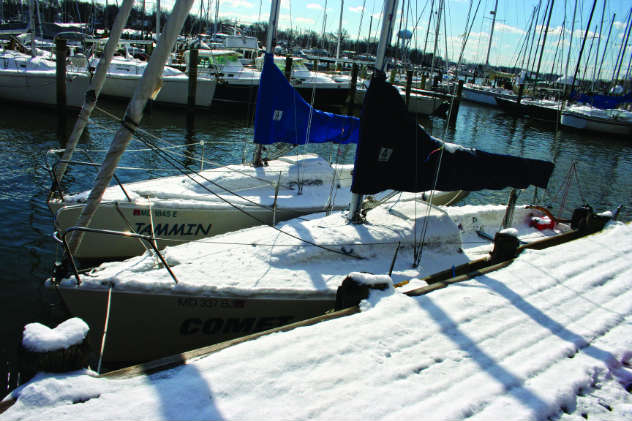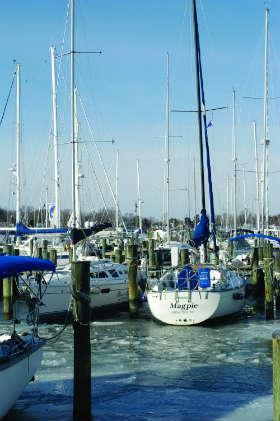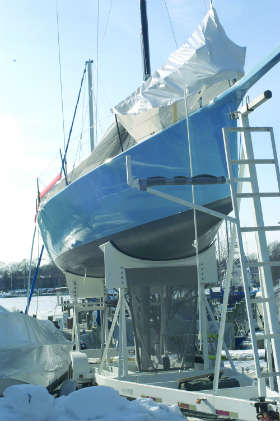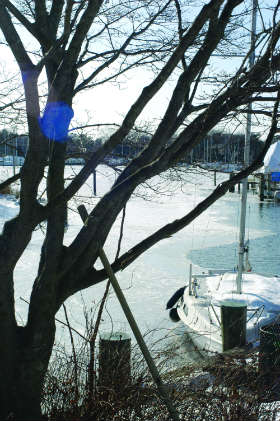Six boat winterization Questions and Answers: It isn’t just changing the oil, emptying fluids, and adding antifreeze—the kind of chores that are usually on checklists for boat winterization. Late fall also is the best time for you to determine what repairs and upgrades your boat needs and arrange to get them done or do them yourself, before the cold weather sets in.
Steve Zimmerman, a longtime custom boat-builder whose Zimmerman Marine company operates four boatyards in Maryland and neighboring states, says preparation for winter is especially important. Freezing temperatures and exposure to snow and ice can degrade your boat and its operating systems and cost you even more to repair the damage in the spring.
“If you winterize your boat properly, it could be at least twice as big a job as the re-commissioning that you perform every spring,” Zimmerman says. And winterizing takes a lot more planning if you want to get everything accomplished smoothly before the freezing temperatures begin.
“Take care of it during the winter and it won’t be a problem next spring,” Zimmerman says. “The last thing you want when spring comes is to find out that your alternator isn’t working or that you have some other crucial repairs to make. It could put a serious dent in your plans to get out on the water early.”
He also advises that if you plan to haul your boat out of the water for the winter you arrange for that—and any other work you want your boatyard to do—at least a month in advance. Otherwise, you risk delays if your marina already has a full haulout schedule and winter workload and can’t get to your boat until spring.
Here are six questions and answers about winterizing that you may want to consider:
1. What’s the first thing to do in the winterizing process?
Take the boat out for fall sea-trials, check everything while you’re under way, and flag the things you think need attention. Look for oil or water leaks, vibration, loose belts, leaking stuffing- and rudder-boxes, steering problems, difficulties involving shift and throttle controls, and electronics. Inspect the boat again when you get back into port.
Then set priorities: Which items on your list are most important? How much time (and money) will it cost you? Which routine items, such as oil changes, should be on your list?
2. Should you leave your boat in the water for the winter or haul it out and store it on land?
That depends on your boat—and your marine insurance policy. Leaving a fiberglass boat in the water in winter poses several risks. You may increase the risk of blisters on the hull. You’re dependent on batteries or shore-power to operate the bilge pumps and keep the boat afloat. And you may not be able to get to the boat when there’s a problem.
On the other hand, if you’re willing to risk an ice storm or freeze and your boat isn’t likely to need attention during the winter, you may be safe in leaving it in the water. Wooden boats do better that way because the wood doesn’t dry out, as it would if you stored the boat ashore.
(Either way, check your marine insurance policy to see whether you’re covered for the winter.)
Whether you haul your boat out or leave it in the water, be sure to protect it during the winter months, either with a proper canvas cover or by having it shrink-wrapped. “Bad weather degrades your boat,” says Zimmerman. “Leaving it unprotected, whether ashore or in the water, adds six months’ exposure to snow, ice, and winter storms.”
3. When should you haul out?
There are two factors that should dictate your timetable: First, you need to get your boat ashore before the air and water temperatures hit freezing. Second, you’ll need to allow enough time for your boatyard to schedule both the haulout and whatever repairs or maintenance you have on your list. It’s the rush season for the boatyard. Give them a month’s advance notice.
4. What routine chores should be on your winterization list?
Identify every system you have on the boat—electrical, water, plumbing, engine-related—and see what needs to be drained, lubricated, and protected against freezing. If you’re storing your boat on land, leave the seacocks open; if you’re leaving it in the water, close all the seacocks except for the cockpit drains. Drain your water tanks and head holding-tanks.
5. What equipment can you safely leave on the boat during the winter?
Take off and take home or store in a climate-controlled storage facility: your cushions and canvas; sensitive electronic gear; soda cans and beer bottles, which can explode in cold weather; and other liquids that suffer from freezing, such as medicines, cleaning products, and, in fact, most liquids.
6. Is there anything else that isn’t on the standard winterization lists?
Take a sample of your oil every fall, and send it off to a laboratory for analysis. If the lab finds trace metals, such as high amounts of chromium, it could indicate wear on the rings in your engine. But it has to be done at the end of the season, when your oil has been used for 50 hours or more. You can also buy oil-analysis kits at a marine supply store or ask your boatyard.
WINTER CHECKLIST:
Change the engine oil
Add fuel stabilizer to your fuel tank
Change the gear-case lubricant
Pump out holding tank
Check bilge pumps, empty bilges
Drain water tanks
Drain water heater
Drain water system
Replace fuel filters
Replace engine zincs
Run antifreeze through the engine, head, and saltwater systems








